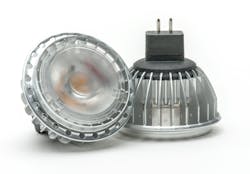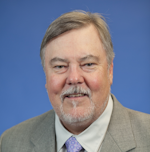Cree has announced LED-based MR16 lamps that operate from transformed 12-VAC input and deliver greater than 80% energy savings relative to legacy halogen lamps. The Cree MR16 Series TrueWhite LED lamp delivers 92 CRI and R9 saturated-red performance above 50 to meet demanding applications in hospitality and retail.
Cree notes that the MR16 sector is one area in which LED lamps haven't performed commensurately with legacy lamps and that has limited LED success in the sector. The US Department of Energy (DOE) recently made the same points in a Caliper report on the sector.
The small form factor of MR16 lamps has been part of the problem with success in the sector. It's difficult both to get the luminous punch and beam control required by applications such as retail and to fit in the required driver electronics. Still, LED lighting companies continue to chase the MR16 market because of the sheer number of sockets where the small lamps are used.
Apparently, the Cree design is largely drawing some interest from customers in the target application. "The Cree MR16 TrueWhite LED lamp is the best 50W halogen replacement lamp to combine the energy-saving benefits of LED with the light distribution and color quality our clients expect," said Lee Mehler, principal architect and president of LMHT Associates/National Restaurant Designers. "We've been disappointed with other MR16 LED lamps on the market, but after testing the Cree MR16 Series TrueWhiteLED lamp we are specifying and recommending the use of this product for new and retrofit projects to replace existing halogen MR16 lamps with Cree."
Cree says that its design includes a light engine that can deliver 540 lm, and optics, including a proprietary lens, that eliminate the glare associated with many MR16 lamps. The company hasn't yet revealed the internals of the lamp design, but the TrueWhite designator implies a 90 or better CRI rating combined with high efficacy. In different products, Cree has mixed red and off-white LEDs or used a neodymium notch filter to achieve the combination of high CRI and efficacy. Most likely, this MR16 lamp simply leverages LED advancements to deliver the high CRI at the component level.
Cree didn't directly tout the efficacy of the product family, but that's likely due to the fact that the system efficacy will depend on the transformer used in the application. Quick calculations would suggest a maximum lamp efficacy of 67 lm/W. That's far below what is being achieved in larger lamp form factors but near the top of the products included in the aforementioned MR16 Caliper report.
Cree is offering the lamps in 15° spot, 25° flood, and 40° wide-flood versions. Center beam candle power (CBCP) is 4648, 2473, and 1296 cd, respectively. The lamp features a 3000K CCT, is designed to last 25,000 hours, and can dim to 5% working with magnetic or electronic ballasts.
While the Cree lamp design is impressive, it will undoubtedly fall short in some demanding applications in hospitality. Many designers will want even warmer 2700K light and the ability to dim below 5%. Moreover, some retail applications may need a higher R9 value. Soraa, for example, has repeatedly touted the R9 performance of more than 90 for its MR16 lamps based on gallium-nitride-on-gallium-nitride (GaN-on-GaN) LEDs. In its recent report, the DOE also noted that some specifiers want MR16 lamps with beam angles as narrow as 4°.
The Cree lamp, however, should find plenty of takers. The company projects that the design will win Energy Star approval in October. The company said payback installing the lamps in place of 50W halogen lamps is less than one year based on 12 hours of usage per day and electric rates of $0.13/kWh.
"Cree's latest innovation is poised to replace the billions of MR16 lamps currently installed around the world by delivering an unprecedented combination of energy savings, color quality, and compatibility," said Norbert Hiller, Cree executive vice president of lighting. "The Cree MR16 Series TrueWhite LED lamp is setting a new standard for the category."







